MabVax Therapeutics Holdings, Inc. (NASDAQ: MBVX) is a biopharmaceutical company developing monoclonal antibody (mAb) products for the treatment of cancer. The company’s novel mAb technology involves a unique twist on the generation of fully human mAbs as they are derived from patients vaccinated with an anti-cancer vaccine, as opposed to antibodies produced in mice or in vitro. The company recently uplisted to the Nasdaq and raised gross proceeds of $9.4 million, which should fund operations well into 2017.
The following is an introductory overview of MabVax to help investors get a better sense of the company’s strategy and opportunity. With preliminary results set to be released from two Phase 1 clinical trials in the next few weeks, I encourage all small-cap biotech focused investors to put MabVax on their radar screens.
Quick Background On Monoclonal Antibodies
Antibodies are a group of specialized proteins produced by the immune system. Their purpose is to bind to foreign antigens (e.g., viruses, bacteria, or foreign proteins) and alert the immune system to clear the invading pathogen from the host. Antibodies are produced by B-cells, and each B-cell is capable of producing a unique antibody that can bind to a single, unique epitope (a specific area of an antigen). A typical immune response results in the production of multiple antibodies that react to multiple epitopes on an antigen. Thus, there are potentially tens to hundreds of B-cells that are producing antibodies to a specific antigen, with each antibody binding to a different portion of the antigen.
Some of these antibodies will be highly effective, while others will only be marginally so. The host’s immune system then deduces which antibodies are most effective, and ultimately makes an abundant amount of those antibodies until the pathogen is eliminated. This is what’s known as a ‘polyclonal’ response (multiple monoclonal B-cell’s making multiple different antibodies).
Scientists long ago recognized the potential power of antibodies and devised multiple means to identify a unique B-cell clone capable of producing a superior antibody for an intended purpose. The antibody produced by the selected B-cell is then cloned such that it can be produced recombinantly in cell culture. These ‘monoclonal antibodies’ have been turned into multiple blockbuster medications for the biotechnology industry, as shown in the following chart that lists the top selling mAbs for 2015.
 MabVax Discovery Platform
MabVax Discovery Platform
MabVax is utilizing fully human monoclonal antibodies derived from a novel means of production. In contrast to how antibodies are currently produced (from immunized mice or from in vitro libraries of antigen binding domains), MabVax’s antibodies are derived from patients immunized with a cancer vaccine. The cancer vaccines are designed to elicit an immune response to a highly specific antigen found almost exclusively on cancer cells. The company’s lead antibody product, HuMab-5B1, was derived from a patient immunized with a cancer vaccine targeting sialyl Lewisa (sLea), a carbohydrate antigen found almost exclusively on cancer cells.
Seven patients with Stage IV breast cancer were initially immunized with sLea vaccine over five years ago. Following immunization, B-cells from each of these patients were screened to identify clones that produced high-affinity antibodies to sLea, with the optimal antibodies genetic sequences cloned such that they can be produced recombinantly. While anecdotal, it is interesting that the patient from whom HuMab-5B1 was cloned is still alive over five years after being immunized with the vaccine.
To summarize, mAbs are highly specialized proteins that bind with high specificity and affinity to unique antigens. Their specificity means that “off-target” effects are limited since the antibodies bind to only one antigen. MabVax is developing fully human mAbs that are directed against an antigen that is highly expressed on certain types of cancer while having a very limited expression in normal tissues, which should avoid any “on-target, off-cancer” effects. In addition, the high specificity to a unique cancer antigen means that the antibodies could be used as efficient vehicles for delivering cytotoxic payloads specifically to tumors.
An Introduction To HuMab-5B1
MabVax’s lead antibody product is HuMab-5B1, which targets the carbohydrate moiety sLea. The company is taking advantage of the antibody’s high specificity and minimal off-target binding to develop it through multiple pathways: as a therapeutic (MVT-5873), an imaging agent (MVT-2163), and a radioimmunotherapy (MVT-1075) for patients with pancreatic cancer. The company is also developing an antibody-drug conjugate based on HuMab-5B1, but that compound will not enter the clinic until the second half of 2017.
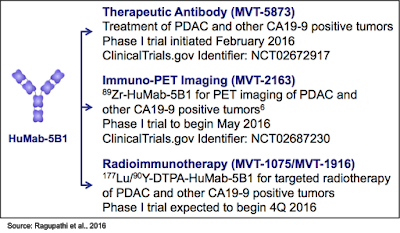 sLea – What You Need To Know
sLea – What You Need To Know
sLea antigen (also known as CA19.9) is a tetrasaccharide carbohydrate that is expressed in large quantities on a number of different types of epithelial cancers. It is found in up to 92% of pancreatic cancers and its expression is correlated with more aggressive phenotypes (1). Assays to detect sLea have been available for over two decades; however, their use is typically limited to monitor disease progression, and not necessarily to aid in diagnosis.
MabVax has accumulated data that shows sLea is expressed abundantly on a number of different tumor types, as shown in the following figure. While limited staining has been seen in healthy tissue, it is considered physiologically irrelevant since it is confined to areas of the body that are not accessible to circulating antibodies.
 MVT-5873
MVT-5873
MabVax is denoting HuMab-5B1 used as a therapeutic as MVT-5873. The antibody has shown strong activity in multiple pre-clinical models utilizing xenografts of human cancer cell lines. Initial work with the antibody in a xenograft model using Colo205 cells (a human colorectal cancer cell line) showed that treatment with four doses of MVT-5873 during the first 21 days following tumor engraftment resulted in a doubling of median survival time and six doses of MVT-5873 resulted in three of five mice surviving to the end of the experiment (2).
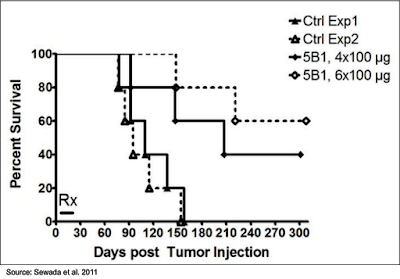
Additional data disclosed by the company showed that MVT-5873 synergized well with standard-of-care (SoC) therapies in a pancreatic cancer xenograft model using BxPC3 cells. The following graph shows that compared to SoC treatment, the addition of MVT-5873 resulted in up to a 50% inhibition of tumor growth, an effect that was dose dependent.
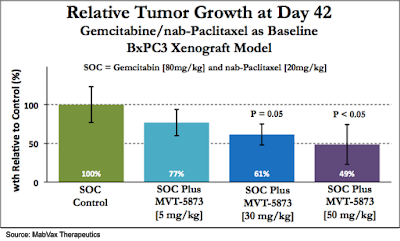
– MVT-5873 Phase 1 Clinical Trial
The company is currently conducting a Phase 1 clinical trial to test the safety of MVT-5873 and determine the maximum tolerated dose (MTD) that can be utilized in combination with SoC gemcitabine and nab-paclitaxel in patients with pancreatic cancer or other CA19.9 expressing cancers (NCT02672917). Patients will be treated with escalating doses of MVT-5873 to assess safety and pharmacokinetics as well as to determine the MTD. Dose expansion will then continue with 10 patients using the recommended Phase 2 dose. In the second portion of the trial, MVT-5873 at one dose less than the MTD will be used in combination with gemcitabine and nab-paclitaxel in 10 patients. Secondary objectives of the trial include evaluating tumor responses by RECIST 1.1 as well as the duration of response.

The company has disclosed in regulatory filings that twelve patients have been treated thus far, with nine through the safety evaluation time period. Of those nine, four patients are into the fourth cycle of treatment and one patient is into the fifth cycle. Four patients have a stable disease as assessed by CT scans. Biomarker analysis shows CA19.9 has decreased in all patients, including measuring in the normal range for three patients with stable disease. These early results are promising, and additional preliminary data are likely to be released by the end of the third quarter, representing a potential near-term catalyst for the stock.
MVT-2163
MVT-2163 is the HuMab-5B1 antibody attached to the radionuclide 89Zr through a chemical linker. The product is being developed as a next-generation imaging agent for Positron Emission Tomography (PET). Currently, PET imaging for cancer utilizes fluorodeoxyglucose (FDG) as an imaging agent. FDG is a glucose analog with the radionuclide 18F substituted in place of a hydroxyl group on the glucose carbon chain. Cells take up FDG in the same fashion as glucose; however, once inside a cancer cell, FDG gets “trapped” as it is not metabolized like glucose and thus accumulates. This accumulation can then be visualized by PET scan, as shown in the following image.
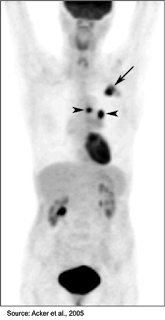
While FDG has advanced the field of tumor imaging, other highly metabolic organs besides the tumor show uptake of FDG, including the brain, heart, and (since it is excreted in the urine) the bladder. This potentially hinders the detection of all tumors, particularly smaller metastases. Thus, an imaging agent that shows high specificity for tumor cells could potentially eliminate off-target labeling and also help to detect smaller metastases that may not be detected with FDG.
MabVax is utilizing the radionuclide 89Zr for the development of its next-generation imaging product. The physical and chemical characteristics of 89Zr make it a very appropriate agent for labeling of a mAb, as its half-life (3.3 days) closely matches the time necessary for an antibody to achieve optimal tumor binding (2-4 days) (3). Labeling an antibody with 18F (which is used for FDG) would not be possible since its short half-life (110 min) would not allow time for the antibody to fully saturate the tumor before all the radioactivity had dissipated.
Preclinical data accumulated for MVT-2163 shows that the compound has highly selective uptake by tumors with little to no off-target binding. The following figures show images obtained from mice harboring orthotopic BxPC3 tumors (a human pancreatic cancer cell line) following administration of FDG-PET (left image) or MVT-2163 (right image). There is a high degree of FDG uptake in the heart and bladder with some uptake by the tumor; however, it is only slightly above background. In contrast, there is virtually no off-target uptake of MVT-2163, making the tumor easily detectable.
– MVT-2163 Phase 1 Clinical Trial
MabVax has initiated a Phase 1 clinical trial of MVT-2163 for patients with locally advanced or metastatic pancreatic cancer (NCT02687230). This is an open-label, non-randomized dose escalation/expansion study that is testing the safety and pharmacokinetics of MVT-2163 when dosed alone and in combination with MVT-5873. The addition of MVT-5873 is being employed in an attempt to “soak up” circulating sLea that could interfere with the PET images. The company will also examine the optimal day for PET imaging following administration of MVT-2163. The study will have three cohorts: 1) patients will be administered only MVT-2163; 2) patients will be administered 17 mg of MVT-5873 followed by MVT-2163; 3) patients will be administered 47 mg MVT-5873 followed by MVT-2163.
The company has disclosed in regulatory filings that one patient has been dosed with MVT-2163 and received PET scans on days 1, 2, 4, and 7. The investigator observed, “scans potentially highlighting smaller metastatic sites not seen on standard CT scans”. This sounds very encouraging; however, it must be reiterated that it is only one patient. The company is likely to release additional preliminary data before the end of the third quarter of 2016, and it will be interesting to see if scans obtained from additional patients continue to show such encouraging results.
MVT-1075
MVT-1075 is a radioimmunotherapy (RIT) comprised of the HuMab-5B1 antibody attached to the radionuclide 177Lu. As opposed to PET imaging, in which a positron-emitting radionuclide is used, the purpose of a RIT is to deliver cytotoxic doses of radioactivity to a tumor. 177Lu is a beta particle emitter with a short range (1.6 mm), thus the radioactive dose can be concentrated at the site where the antibody is bound, thus potentially decreasing side effects. In addition, the 6.7-day half-life of 177Lu compares favorably with the binding kinetics of a monoclonal antibody on the target tissue.
The preclinical data accumulated thus far for MVT-1075 is quite strong and could point to the compound being the most important asset MabVax has in development. The following slide taken from the company’s investor presentation shows that treatment of mice bearing tumor xenografts with MVT-1075 results in suppression of tumor growth and tumor cell killing with a vast majority of the compound accumulated on the tumor and not in off-target tissues.
There have been two RIT’s approved by the FDA: Zevalin® (an anti-CD20 antibody attached to 90Y) and Bexxar® (an anti-CD20 antibody attached to 131I). Neither of these antibodies are commercial successes, as Zevalin® had peak sales of $30 million in 2012 and Bexxar® had peak sales of $9 million in 2010. Some may look at those numbers and be wary of another RIT product; however, I believe that the reason these drugs were unsuccessful has nothing to do with the fact that they are RITs, but instead was due to a sub-optimal target antigen selection and logistical issues around the products use in the clinic. Based on the highly specific binding capabilities of HuMab-5B1 and the very strong preclinical data, I think MVT-1075 is much more likely to be a clinical and commercial success.
The company is planning to file an IND for MVT-1075 in the fourth quarter of 2016. The data accumulated for MVT-2163 will be very similar to what can be expected for MVT-1075, as the only difference between the two will be the cytotoxicity of the radionuclide for MVT-1075. Thus, positive data for MVT-2163 should be viewed as a significant de-risking event for MVT-1075.
HuMab-5B1 Antibody Drug Conjugate
MabVax is also developing a HuMab-5B1 based Antibody Drug Conjugate (ADC) based on the ability of HuMab-5B1 to be internalized by cancer cells following binding to sLea on the cell surface. This internalization allows for the antibody to be used as a delivery vehicle to get a toxic payload inside the cell, as shown in the following figure.

The preclinical data for the ADC product is just as encouraging as for MVT-1075. The following graph shows dose-dependent tumor suppression and regression when using the HuMab-5B1 ADC compound at the highest dose. Importantly, the treatment was quite tolerable, as mice treated with increasing amounts of toxin did not exhibit any weight loss during the experiment, which can be a sign of toxicity.
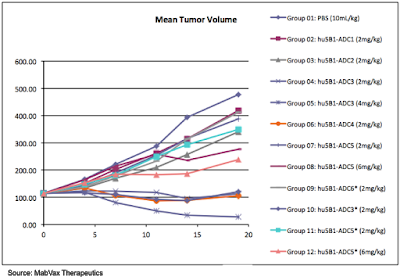
MabVax has indicated that lead candidate selection for an ADC product will be completed by the end of 2016 such that an IND can be filed in the second half of 2017.
Pancreatic Cancer Market
MabVax is developing HuMab-5B1 as a therapeutic, a next-generation imaging agent, and a RIT for patients with pancreatic cancer, which is one of the most deadly forms of cancer. This is because pancreatic cancer typically has few if any symptoms early on, and it is not until the cancer has metastasized, or spread to other parts of the body, that patients will begin to experience noticeable symptoms. Due to the fact it is rarely found before metastasizing, the five-year survival rate for patients with pancreatic cancer is very low (4).
The only potential cure for pancreatic cancer is surgery; however, only approximately 20% of patients are even eligible for surgery. This is due to the fact that the surgery itself is quite complicated since the pancreas is located deep within the abdomen and is connected to a number of different organs and major blood vessels. Even for those patients whose tumors are fully resected with surgery, approximately 80% of them will suffer a recurrence within two years.
Standard of care treatment for metastatic pancreatic cancer is the chemotherapeutic agent gemcitabine either as a monotherapy or in combination with erlotinib (Tarceva®) or nab-paclitaxel (Abraxane®). The use of gemcitabine and erlotinib resulted in one-year survival rates of 23% compared to just 17% for patients treated with only gemcitabine along with an increase in overall survival from 5.91 months to 6.24 months (5). Nab-paclitaxel combined with gemcitabine resulted in an even greater increase in overall survival from 6.7 months to 8.5 months (6). However, given that overall survival rates when using each of these treatments is still well below a year, it is clear that more efficacious therapeutic options are desperately needed.
Conclusion
MabVax’s unique antibody discovery platform differentiates it from other companies developing antibody therapeutics as it allows for the generation of fully human antibodies while also taking advantage of the capabilities of the human immune system to generate products that are highly specific and efficacious. The company’s unique platform also allows for the use of lead antibody products in a number of different modalities, as exemplified by the development of HuMab-5B1 as a therapeutic agent, an imaging agent, a RIT, and an ADC.
The company will likely be announcing preliminary data from the two ongoing Phase 1 clinical trials for MVT-5873 and MVT-2163 in the next few weeks and I will post an update with an analysis of the data after it is released. The data for MVT-2163 could be particularly important, as positive imaging data could be viewed as a read-through for MVT-1075, as the two compounds will only differ by the type of radionuclide attached to them. If MVT-2163 shows selective binding to tumors, then MVT-1075 is likely to behave in a very similar fashion, at which point the efficacy of the drug will depend entirely on 177Lu, which has shown excellent activity in preclinical models.
The company recently completed a 1-for-7.4 reverse split, uplisted to the Nasdaq, and raised gross proceeds of $9.4 million. The company may also be eligible for the second $5 million tranche from a loan agreement with Oxford Finance, LLC. The second tranche is obtainable upon positive interim data from the Phase 1 study of MVT-5873. Thus, the company should have sufficient funds to get through the final data readouts for both Phase 1 studies.
Pancreatic cancer has proven incredibly difficult for drug developers to produce efficacious treatments; however, I believe HuMab-5B1 has the potential to make a real impact due to its high specificity and efficacy in pre-clinical models, particularly as a RIT or ADC product. MabVax currently has a market cap of approximately $28 million, and since a successful pancreatic cancer treatment would easily produce >$500 million in peak revenues, the risk/reward profile for MabVax is quite compelling at its current valuation.


